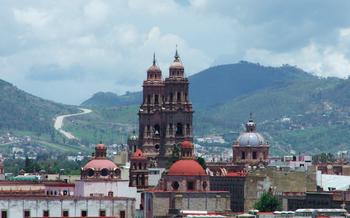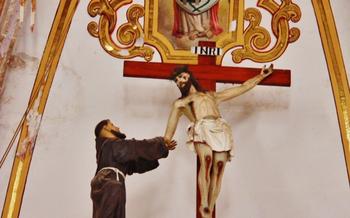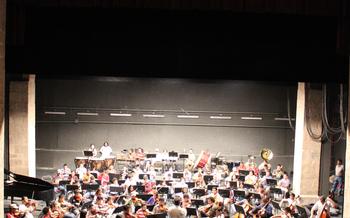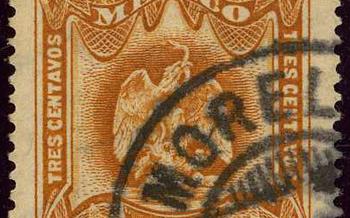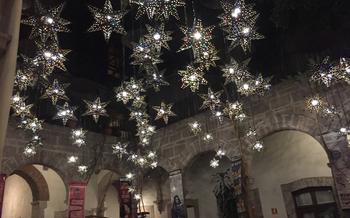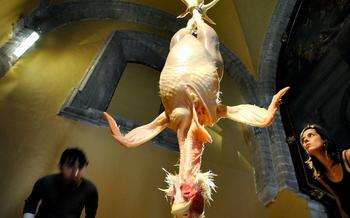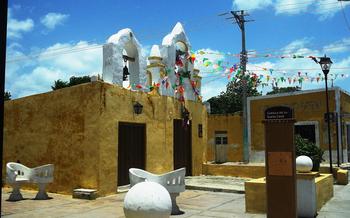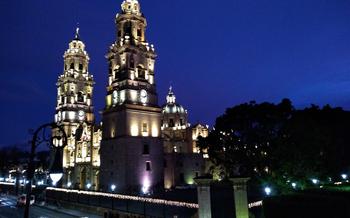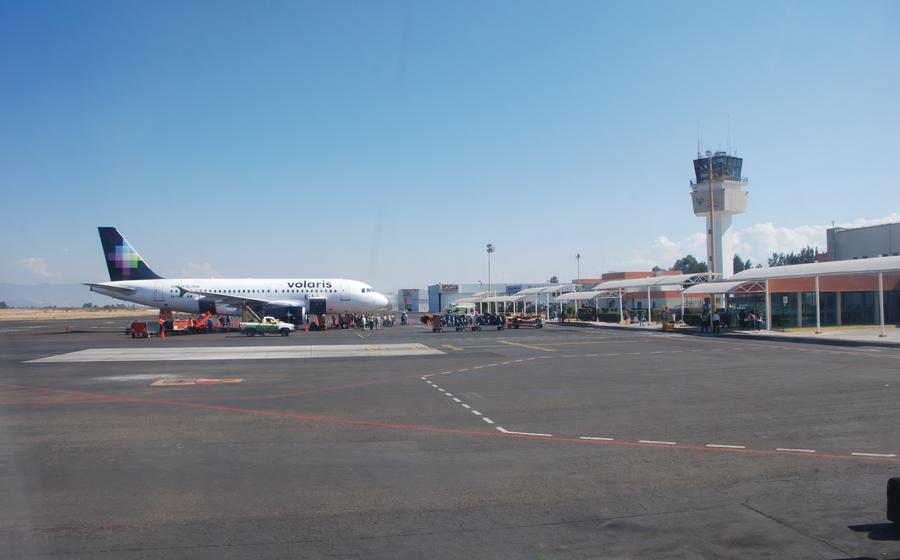
Piedras Encimadas de Zacapu
- Getting to the Piedras Encimadas de Zacapu
- The Legend of the Piedras Encimadas de Zacapu
- Camping and Outdoor Activities
- Photography and Nature Appreciation
- Visiting the Nearby Town of Zacapu
- Best Time to Visit the Piedras Encimadas de Zacapu:
- Planning Your Trip
- Guided Tours and Local Experts
- Cultural Etiquette and Respect
- Accessibility and Inclusivity
- Sustainability and Conservation
- Insider Tip: Unraveling the Hidden Secrets
Getting to the Piedras Encimadas de Zacapu
The Piedras Encimadas de Zacapu are situated in the town of Zacapu, approximately 70 kilometers (43 miles) west of Morelia, the capital of the Mexican state of Michoacán. The site is easily accessible by car, and there are several transportation options available for visitors who do not have their own vehicle.
To reach the Piedras Encimadas de Zacapu by car, take the highway from Morelia to Zacapu. The drive takes about an hour and a half. Once you arrive in Zacapu, follow the signs to the Piedras Encimadas. There is a parking lot available at the site, where you can leave your car for a small fee.
If you do not have a car, you can take a bus from Morelia to Zacapu. The bus ride takes about two hours. Once you arrive in Zacapu, you can take a taxi or a local bus to the Piedras Encimadas.
No matter which transportation option you choose, getting to the Piedras Encimadas de Zacapu is relatively easy and straightforward. Once you arrive, you will be rewarded with stunning views of these ancient rock formations.
The Legend of the Piedras Encimadas de Zacapu
The Piedras Encimadas de Zacapu have been the subject of many myths and legends passed down through generations by the local community. One of the most popular stories tells of a giant who, in a fit of rage, threw enormous boulders across the land, creating the rock formations we see today. Another legend speaks of a princess who was transformed into a rock by a jealous witch, and her tears formed the pools of water that can be found at the site.
These legends have deep cultural significance for the people of Zacapu, as they reflect their beliefs and traditions. Storytelling is an important part of the local culture, and these stories are often shared around campfires or during festivals, helping to preserve the rich oral history of the region. The Piedras Encimadas de Zacapu are not just geological wonders but also symbols of the region's cultural heritage.
Camping and Outdoor Activities
Nestled amidst the majestic rock formations, designated camping areas provide an immersive experience for outdoor enthusiasts. These campsites offer basic amenities, including restrooms, picnic tables, and fire pits, allowing visitors to connect with nature and embrace the tranquility of the surroundings.
For those seeking a more adventurous escapade, hiking trails of varying difficulty levels wind through the captivating landscape, leading to breathtaking viewpoints that offer panoramic vistas of the Piedras Encimadas de Zacapu and the surrounding countryside. Mountain biking enthusiasts can embark on thrilling trails that traverse rugged terrain, providing an exhilarating adrenaline rush while immersing themselves in the natural beauty of the region.
The diverse ecosystem that surrounds the Piedras Encimadas de Zacapu is home to a rich variety of wildlife, making it a paradise for birdwatchers and nature enthusiasts. With a keen eye, visitors can spot colorful bird species flitting among the trees, while patient observers may catch a glimpse of elusive mammals roaming the underbrush.
Photography and Nature Appreciation
The Piedras Encimadas de Zacapu is a photographer's paradise, offering breathtaking views and unique photo opportunities at every turn. The massive boulders, set against the backdrop of the surrounding hills and valleys, create a surreal and awe-inspiring landscape that begs to be captured on camera. Whether you're a professional photographer or simply enjoy taking snapshots, you'll find endless inspiration here.
The region is also home to a diverse array of flora and fauna, making it a haven for nature lovers and wildlife enthusiasts. Keep an eye out for endemic plant species, such as the Zacapu sage and the Zacapu milkweed, as well as a variety of birds, reptiles, and mammals that call this area home. With a little patience and observation, you may even catch a glimpse of the elusive Zacapu deer, known for its distinctive antlers and shy nature.
Remember to tread lightly and respect the fragile ecosystem while exploring the area. Bring a reusable water bottle to stay hydrated, pack a lunch to minimize waste, and leave no trace of your visit. By embracing responsible tourism practices, you can help preserve the natural beauty of the Piedras Encimadas de Zacapu for generations to come.
Visiting the Nearby Town of Zacapu
While exploring the Piedras Encimadas de Zacapu, don't miss the opportunity to visit the nearby town of Zacapu, located just a short drive away. This charming town boasts a rich history and culture, with colonial architecture, historical landmarks, local markets, and culinary delights that will tantalize your taste buds.
Zacapu is steeped in history, with colonial-era buildings that line its streets and tell tales of a bygone era. Admire the intricate facades and explore the town's historical landmarks, including the Parroquia de San Francisco, a stunning 16th-century church that showcases a blend of Gothic and Renaissance architectural styles.
No visit to Zacapu is complete without experiencing its vibrant local markets. Immerse yourself in the sights, sounds, and aromas of the bustling Mercado Municipal, where you can find an array of fresh produce, handcrafted souvenirs, and local delicacies. Be sure to sample the town's signature dish, the delicious "carnitas de Zacapu," a mouthwatering slow-cooked pork dish that is a testament to the region's culinary prowess.
Zacapu also hosts cultural events and festivals throughout the year that celebrate the town's rich traditions and heritage. Don't miss the annual Feria de Zacapu, a lively festival that takes place in September and features traditional music, dance, and food, as well as a colorful parade that showcases the town's cultural pride.
Best Time to Visit the Piedras Encimadas de Zacapu:
Timing plays a crucial role in enhancing your experience at the Piedras Encimadas de Zacapu. The ideal period to visit is during the dry season, which typically runs from November to April. During this time, the weather remains pleasant, with clear skies and moderate temperatures. The reduced rainfall ensures that the trails are dry and easily navigable, allowing you to fully explore the rock formations without any hindrance.
Seasonal variations can affect your experience. The summer months, from May to October, bring higher temperatures and increased humidity, making outdoor activities less comfortable. However, this period also coincides with the rainy season, which can occasionally lead to trail closures due to muddy or slippery conditions. It's advisable to check the weather forecast before planning your visit during these months.
To avoid crowds and enjoy a more serene atmosphere, consider visiting on weekdays instead of weekends. Peak tourist seasons, particularly during Mexican holidays and festivals, can attract a large number of visitors, making it more challenging to fully appreciate the natural beauty of the site.
Planning Your Trip
When planning your trip to the Piedras Encimadas de Zacapu, consider staying for at least one or two nights to fully experience the natural beauty and cultural charm of the region. Morelia offers a wide range of accommodation options, from charming boutique hotels to budget-friendly hostels. Zacapu also has a selection of hotels and guesthouses that provide a more intimate local experience.
When packing for your trip, be sure to include comfortable hiking shoes, a hat, sunscreen, and plenty of water. Layers are recommended as the temperature can vary throughout the day. A flashlight or headlamp is useful for exploring the caves and crevices of the rock formations, especially if you plan to visit at night.
For safety, it's essential to be aware of your surroundings and to stay on marked trails while exploring the site. It's also advisable to inform someone about your itinerary and to carry a map or GPS device.
Guided Tours and Local Experts
Booking a guided tour to explore the Piedras Encimadas de Zacapu offers several advantages. Experienced tour guides provide insightful commentary on the history, geology, and cultural significance of the site, enhancing your understanding and appreciation. They can lead you to the most scenic viewpoints, hidden caves, and unique rock formations, ensuring you don't miss any of the highlights.
Choose reputable tour operators that prioritize safety, sustainability, and cultural sensitivity. They often have exclusive access to restricted areas and can arrange for special experiences like night-time stargazing or sunrise hikes. By supporting local guides, you contribute to the preservation of the region's cultural heritage and traditions while ensuring a positive impact on the community.
The knowledge and expertise of local guides are invaluable in unlocking the secrets of the Piedras Encimadas de Zacapu. Their passion for the region is contagious, making your visit not just an adventure but an immersive cultural experience.
Cultural Etiquette and Respect
When visiting the Piedras Encimadas de Zacapu, it is essential to be mindful of the local culture and traditions. The community takes pride in its heritage and customs, and visitors should strive to respect and appreciate them. Interacting with the locals with a friendly and open demeanor is highly encouraged. Greetings and farewells are customary, and a smile can go a long way in fostering positive connections.
It is important to dress modestly and refrain from wearing revealing clothing, especially when visiting sacred sites or religious establishments. Respecting local customs and traditions shows consideration for the community and helps preserve the integrity of the cultural heritage.
Supporting local businesses and initiatives is a great way to contribute to the community's economic well-being. Purchasing souvenirs from local artisans, dining at traditional restaurants, and participating in cultural events not only supports the local economy but also allows visitors to experience the authentic flavor of the region.
Remember, responsible tourism is about respecting the people, their culture, and the environment. By being mindful of local customs and traditions, visitors can help preserve the unique charm and character of the Piedras Encimadas de Zacapu and its surrounding communities.
Accessibility and Inclusivity
The Piedras Encimadas de Zacapu is committed to providing an accessible and inclusive experience for all visitors. Accessibility features such as ramps, designated parking spaces, and accessible restrooms make it easy for visitors with disabilities to navigate the site. Braille signage and audio guides are also available for visually impaired visitors.
Trained staff members are on hand to assist visitors with disabilities, ensuring they have a safe and enjoyable experience. The visitor center provides information on accessible trails and viewpoints, as well as recommendations for nearby attractions that cater to visitors with specific needs.
The Piedras Encimadas de Zacapu also promotes inclusivity by welcoming visitors from all backgrounds and cultures. The park offers multilingual brochures and guided tours in multiple languages to ensure that everyone can learn about the site's history and significance.
By embracing accessibility and inclusivity, the Piedras Encimadas de Zacapu creates a welcoming and enjoyable environment for all visitors, regardless of their abilities or backgrounds.
Sustainability and Conservation
As a responsible traveler, it is essential to prioritize sustainability and conservation when visiting the Piedras Encimadas de Zacapu. Here are some tips for minimizing your environmental impact and supporting local conservation efforts:
-
Respect the Natural Environment: Refrain from littering, disturbing wildlife, or damaging the rock formations. Leave no trace of your visit and always pack out what you pack in.
-
Support Local Conservation Initiatives: Consider donating to organizations dedicated to preserving the natural beauty of the region. These organizations work tirelessly to protect the environment and ensure its longevity for future generations.
-
Practice Responsible Hiking: Stay on designated trails to prevent erosion and damage to the delicate ecosystem. Avoid picking flowers or plants, as they play a vital role in the local biodiversity.
-
Educate Yourself and Others: Spread awareness about the importance of conservation and responsible tourism among your fellow travelers. Encourage others to adopt sustainable practices and respect the natural environment.
-
Choose Sustainable Accommodations: Opt for hotels or lodges that prioritize sustainability, such as those that use renewable energy sources, reduce water consumption, and support local communities.
Insider Tip: Unraveling the Hidden Secrets
To truly immerse yourself in the magic of the Piedras Encimadas de Zacapu, venture beyond the main trails and discover hidden gems waiting to be unearthed. Explore lesser-known viewpoints that offer breathtaking panoramas and capture the essence of the natural landscape. Seek out secluded rock formations where you can enjoy a tranquil picnic surrounded by nature's tranquility. Engage with the local community and ask for their recommendations; they might share secret spots that only locals know about. Whether it's a hidden cave, a secluded waterfall, or a breathtaking sunset viewpoint, embrace the spirit of exploration and uncover the secrets that make this place truly special.
